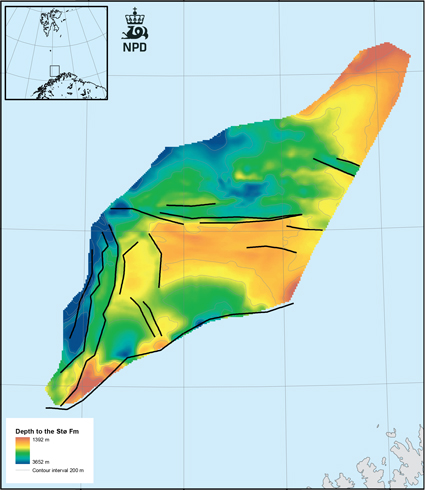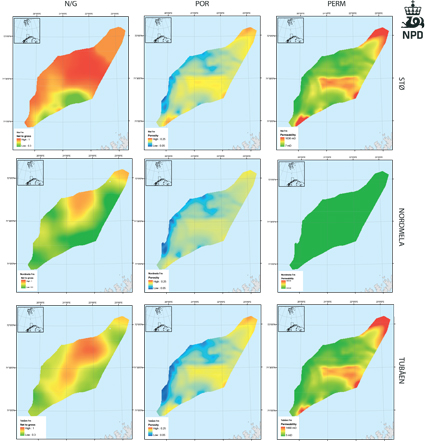Hammerfest Basin
In the Hammerfest Basin, the Jurassic Tubåen, Nordmela and Stø Formations increase in thickness towards the west. The western part of the basin is bounded by large faults to the north and south which juxtapose the Jurassic aquifer towards tight Triassic formations. Towards the northeast, the Jurassic aquifers subcrop against the sea floor with a thin Quaternary cover, while in the eastern part there is a gradual transition to thinner formations in the Bjarmeland Platform aquifer. Faults within the basin commonly juxtapose Stø towards the Nordmela and Tubåen Formations. Paleofluid contacts indicate that the faults are open where there is sand-sand contact.
Pressure data from exploration wells show that the Jurassic formations are hydrostatically pressured at depths shallower than 2600 m. The data indicates that the pore pressure has equilibrated between the three formations. The most important regional stratigraphic barrier in the succession is considered to be the shaly lower part of the Nordmela Formation. Pressure data indicate that the thin shaly continuous layers in the middle part of the Stø Formation can create baffles for vertical flow during production. In general, the Tubåen and Nordmela Formations are heterogeneous reservoirs where individual channels have good reservoir properties while they may be poorly connected to other parts of the reservoir.
For the evaluation of storage potential, it was decided to define the Stø, Nordmela and Tubåen Formations as one single aquifer system. The geological data show that the Stø Formation is very well connected laterally. The underlying, heterolithic formations are believed to contribute to the aquifer at a regional scale. At a smaller scale, in an injection site, stratigraphic barriers may allow gas to accumulate at different stratigraphic levels within a structural closure. This is shown by local small oil and gas accumulations below the main contacts of the Snøhvit and Albatross accumulations. The experience from CO2 injection in the Snøhvit Field showed that CO2 was contained within the Tubåen Formation with no upwards migration into the Nordmela and Stø Formations.
The calculations of storage capacity in structures are based on injection and storage in the Stø Formation. For the aquifer volume, the storage capacity includes the Nordmela and Tubåen Formations. Experience from Snøhvit CO2 injection shows that many injection wells may be needed to realize a large storage potential in these heterolithic formations. The formation water in the aquifer is strongly saline, with salinities generally exceeding 100 000 ppm. The water density at standard conditions in the Snøhvit Field is around 1.1 g/cm3.
Somewhat lower salinity is indicated in the 7125/4-1 discovery and in some wells in the southwestern part. High salinity may cause problems for CO2 injection due to salt precipitation near the wells. Another effect of salinity is that CO2 is less soluble in high salinity brines than in sea water. The amount of CO2 trapped by dissolution can then be relatively small.
Residual oil is widely distributed in the Jurassic Hammerfest Basin aquifer. Apparently, the mega-structures in the central part of the basin were filled with oil and gas at the time of maximum burial. Large volumes of gas have seeped out, whereas the oil is still remaining. The oil saturation is believed to be small. Theoretically, residual oil will reduce the effective permeability of the aquifer due to relative permeability effects.
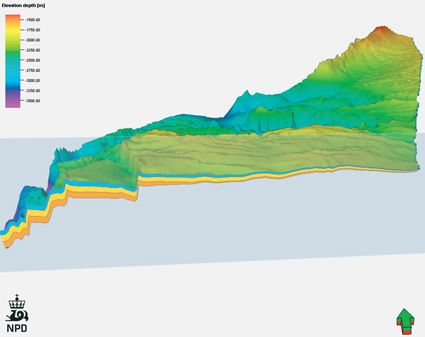
Fig-6-057
W–E cross section through the Hammerfest Basin 3D geological model, showing the Stø, Nordmela and Tubåen aquifers in blue, yellow and orange respectively.
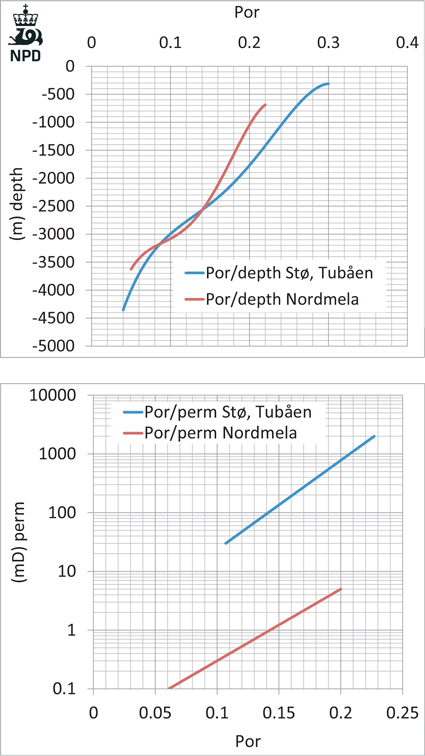
Fig-6-058
Porosity / depth and porosity / permeability plots based on core and log data from the Hammerfest Basin.
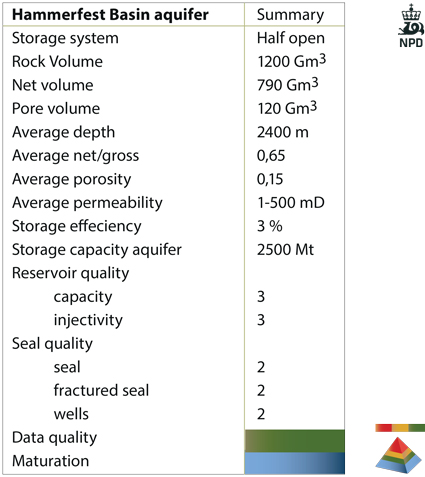
Fig-6-059
